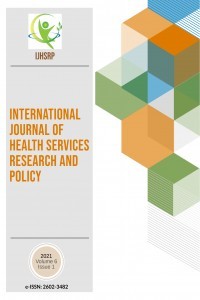PEDIATRIC NURSES’ ATTITUDES REGARDING MALPRACTICE TENDENCIES AND PATIENT SAFETY CULTURE: A CASE OF TURKEY
PEDIATRIC NURSES’ ATTITUDES REGARDING MALPRACTICE TENDENCIES AND PATIENT SAFETY CULTURE: A CASE OF TURKEY
Background: Pediatric nurses provide care to children, which is why they play an essential role in preventing medical errors and ensuring patient safety.
Objectives: This comparative and descriptive study was conducted to determine the attitudes of pediatric nurses in Turkey regarding malpractice tendencies and patient safety culture and to reveal the relationship between them.
Material and Methods: The study was conducted in the pediatric clinics of a university hospital and a public hospital in a metropolis in the northern region of Turkey. The study population included 142 nurses. A ‘Nurse Information Form’, a ‘Patient Safety Culture Scale (PSCS)’, and a ‘Malpractice Tendency Scale in Nursing (MTSN)’ were used to collect information. Data were analyzed by using SPSS 16 program, descriptive statistics, Independent Two-Sample t-test, one-way analysis of variance (ANOVA), Tukey test, Tamhane test, Mann Whitney U, Kruskal Wallis test and Pearson correlation tests.
Results: Nurses who had a master’s degree, made a medical error, and observed medical errors made by another colleague had a higher mean MTSN score (p
Keywords:
pediatrics nursing, medical error, patient safety,
___
- 1-Rızalar S, Büyük Tural E, Şahin R. et al. Patient safety culture and ınfluencing factors of nurses. Dokuz Eylul Uni. E-Journal of Nurs. Fac. 2016;9:9-15. [İn Turkish]
- 2- Ersun A, Başbakkal Z, Yardımcı F. et al. A study of the malpractıce trends ın pedıatrıc nurses. J. Ege Uni. Nurs. Fac. 2013;29:33-45. [İn Turkish]
- 3- Seren İntepeler Ş, Dursun M. Medication error and medication error reporting systems. J. Anatolian Nurs. and Health Sci. 2012; 15: 129-135. [İn Turkish]
- 4- Wegner W, Silva SC, Kantorski KJC. et al. Education for culture of patient safety: Implications to professional training. Esc Anna Nery.2016; 20:e20160068.
- 5- Borba Netto CF, Severino Gaderha, F. Results of a safety culture survey in a teaching public hospital in Ceará. Rev Bras Promoç Saúde, 2016;29:334-41.
- 6- Jang HE, Song Y, Kang HY. Nurses' perception of patient safety culture and safety control in patient safety management activities, J Korean Acad Nurs Adm. 2017;23:450-9.
- 7-Başbakkal Z, Taş F. Yılmaz HB. A study on the pediatric nurses’ opinions about patient safety culture. Ege Pediat. Bulletin. 2009; 16: 87-93. [İn Turkish]
- 8- Külcü DP, Yiğit R. Tendency of nurses workıng at pediatric clinics to make medical errors. J. Anatolian Nurs. and Health Sci. 2017;20:34-40. [İn Turkish]
- 9- Özalp Gerçeker G, Akçay Didişen N, Bolışık B. et al. Investıgatıon of the pedıatrıc nurses’ experıences and opınıons about medıcatıon errors and use of generıc drugs. J. Acibadem Uni. Health Sci. 2015; 6:210-5. [İn Turkish]
- 10- Altunkan H. Nursing Malpractice:Konya Example. Master's thesis. Selcuk University Institute of Health Sciences. Konya, Turkey. 2009.
- 11-Türkmen E, Baykal Ü, Seren Ş. et al. Development of patient safety culture scale. J. Anatolian Nurs. and Health Sci. 2011;14:38-46. [İn Turkish]
- 12- Odabaşoğlu E. Malpractice trends of the nurses working in a paediatric clinic and the factors affecting. Master's thesis. Atatürk University Institute of Health Sciences. Erzurum, Turkey.2013.
- 13-Alan N, Khorshtd L. Determınatıon of the level of trends ın medıcal errors of the nurses worked at one unıversıty hospıtal. J. Ege Uni. Nurs. Faculty. 2016;32:1-18. [İn Turkish]
- 14- Yılmaz Z, Göriş S. Determination of the patient safety culture among nurses working at ıntensive care units. Pad J. Medical Science 2015; 31: 597-601.
- 15- Mardon RE, Khanna K, Sorra,J. et al. Exploring relationships between hospital patient safety culture and adverse events. J. Patient Saf. 2010;6: 226–232.
- 16-Wang X, Liu K, You LM. et al. The relationship between patient safety culture and adverse events: a questionnaire survey. Int J Nurs Stud. 2014;51:1114-22.
- 17- Ammouri AA, Tailakh AK, Muliira JK. et al. Patient safety culture among nurses. Inter. Nurs. Review. 2015; 62:102-110.
- 18- Cebeci F, Gürsoy E, Tekingündüz S. Determining the level of tendency in malpractice among nurses. J. Anatolian Nurs. and Health Sci. 2012; 15:188-196. [İn Turkish]
- 19-Özkan S, Kocaman G, Öztürk C. et al. Frequency of pediatric medication administration errors and contributing factors. J. Nursing Care Quality. 2011; 26:136-143.
- 20-Bodur S, Filiz E. A survey on patient safety culture in primary healthcare services in Turkey. Inter. J. Quality Health Care. 2009;21:348–355.
- 21-Rızalar S, Yıldızeli Topçu S. The patient safety culture perception of Turkish nurses who work in operating room and intensive care unit. Pak. J. Med. Sci. 2017;33(2):374-379.
- 22- Hatami N, Keshtkar V, Forouzan F. et al. Patient safety culture status in teaching hospitals: a case of Shiraz University of Medical Sciences. Middle East J. Sci. Research. 2012;12:970- 5.
- 23-Kim, SK, Lee, H. Oh, EG. Perceived level and associated factors of patient safety culture among health care providers in an operating room. J. Korean Cli. Nurs Research 2010;16: 57-67.
- 24-Nordin A, Theander K, Wilde-Larsson B. et al. Health care staffs’ perception of patient safety culture ın hospital settings and factors of importance for this. Open J. Nurs. 2013;3:28-40.
- 25-Özer S, Sarsılmaz Kankaya H, Aktaş Toptaş, H. et al. Attitudes toward patient safety and tendencies to medical error among turkish cardiology and cardiovascular surgery nurses, J Patient Saf. 2019;15: 1-6.
- Yayın Aralığı: Yılda 3 Sayı
- Başlangıç: 2016
- Yayıncı: Rojan GÜMÜŞ
Sayıdaki Diğer Makaleler
EXAMINATION OF NURSING STUDENTS' ACCEPTANCE LEVELS FOR AESTHETIC SURGERY AND AFFECTING FACTORS
Gülten ÇİRKİN TEKEŞ, Reyhan GÜNDÜZ, Nizamettin BOZBAY, Rezan BUĞDAY, Elif AĞAÇAYAK
Esra TURAL BÜYÜK, Nihal ÜNALDI BAYDIN, Özge DÖRAL
LARYNGEAL TUBERCULOSIS – A NEGLECTED DISEASE THAT CAN MIMIC LARYNGEAL CARCINOMA
Jovan JAVORAC, Dejan ŽİVANOVİĆ, Aleksandra LOVRENSKİ, Ana MİLENKOVİĆ, Darinka KUKAVİCA, Miroslav ILİĆ
DETERMINATION OF GENDER PERCEPTIONS OF NURSING AND MIDWIFERY STUDENTS
Seda SÖGÜT, Eda CANGÖL, Gözde ÖZSEZER
Emine KAPLAN SERİN, Semra BÜLBÜLOĞLU
Yeliz ARMAN KARAKAYA, Sevda YILMAZ
DOES PROFESSIONAL VITALITY OF HEALTH CARE WORKERS CHANGE THEIR LEARNED HELPLESSNESS?
